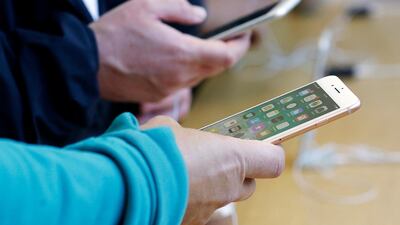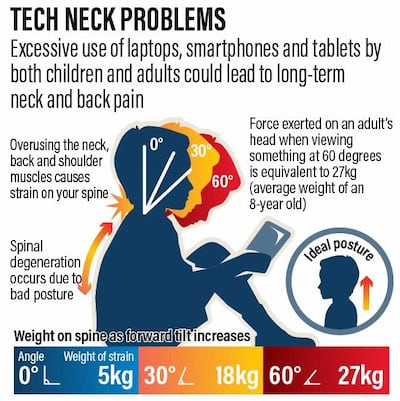Excessive use of laptops, mobile phones and tablets by children is leading to long-term neck and back pain, experts in the UAE have warned.
Health professionals said the growing use of technology in the classroom was causing “rapid spinal degeneration” in youngsters.
Schools around the world are increasingly adopting technology as teaching aids, with children required to spend more time on various mobile devices.
Assignments and homework are often sent and received online, while online textbooks have also become the norm.
“We are seeing rapid spinal degeneration in children,” said Dr Charles Jones, an American chiropractor who has practiced in Dubai for 25 years.
“We have 18 and 19-year-olds coming in with [damaged] cervical discs [in the neck], a condition we don’t usually see until people are in their early 40s.
“From what we can determine, this is due to excessive amounts of time spent on tech devices.”
Chronic neck pain due to the overuse of technology - often referred to as ‘tech neck’ - is a medically acknowledged condition.
While using a device such as a phone or a tablet, the neck is typically bent at a 60-degree angle. At that angle, the neck experiences the same stress as carrying two bowling balls, or around 27 kilos.
Over time, this can result in disc injury in the neck, leading to chronic neck pain as well as degenerative neck conditions.
According to Dr Jones, critical bone development takes place in the body up until the early 20s, and technology is interfering in this crucial development stage in children.
________________
Read More:
Survey reveals UAE is a 'zombie nation' of smartphone users
Back pain: causes, effects and solutions
Victims of lower back pain are getting younger
________________
“We are at a stage where technology and education go hand in hand and finding a happy medium is essential,” he said.
At Nord Anglia International School in Dubai, deputy secondary head Tayyeba Al Qureshi said she recognised the importance of student posture.
She said both parents and teachers had a duty to ensure pupils avoided unnecessary time on mobile devices and - when they were required to use them - how they were sitting was taken into account.
“Staff and parents need to know more about posture and using technology for educational purposes,” she said.
“We’re hoping to build different learning environments that consider the spinal health of the children. It is the parents’, student’s and teacher’s responsibility.”
“It has to come from somewhere; schools or parents or both," said Dr Jones. "Kids are not in school all day.
“When they’re at home, parents need to keep an eye on them. They need to limit time on devices and ensure that the kids do not sit in the same position for more than 30 minutes.
“For every hour of screen time, the child needs 15 minutes of movement time. They need to be taught correct stretches to ease tension and strain on their muscles and bones.
“They need to be taught correct postures while using their devices. Schools need to invest in proper furniture that can facilitate correct posture, options like ergonomic chairs for working on desktops or standing desks.”
Jared Rodgers, head of IT at the American Community School in Abu Dhabi (ACS), said: “ACS Abu Dhabi is making inroads on this topic. We have a variety of seating options to meet the comfort and preferences of the individual learner.
“Stand-up desks, exercise balls, wobble cushions and comfortable couches allow for flexibility and choice with regards to seating in the classroom.”
A survey conducted by YouGov and Omnibus last year found that the average UAE resident spent six hours per day glued to their smartphones.
More than a thousand people responded to a poll asking questions about their phone habits, with 87 per cent saying they would struggle to live without their mobile for just 24 hours.
Marisa Gallaccio, a teacher in the American School of Dubai, said: “Of course technology is important.
“But it is also as important to teach kids not only the correct posture but to offer them furniture in school that can help them.
“In my class I have a mixture of standing desks, balancing balls that they can sit on while they work which maintains a good posture, and the freedom to move around the classroom so they aren’t in a static position for long periods of time.”
How to ease the pain of tech neck:
Make sure all screens, including phones, are brought up to eye level and sit up straight
Take breaks to change position, get up and stretch for 20 or 30 minutes
Consider a standing desk but implement the change gradually
If you work on a laptop regularly, elevate the screen on some books or magazines to eye level, get an external keyboard and mouse, and sit up straight at a table where your hands can be parallel to the board
Alternate between a standing and sitting desk
Stretch: at your desk, in the car, at home and before and after exercise


